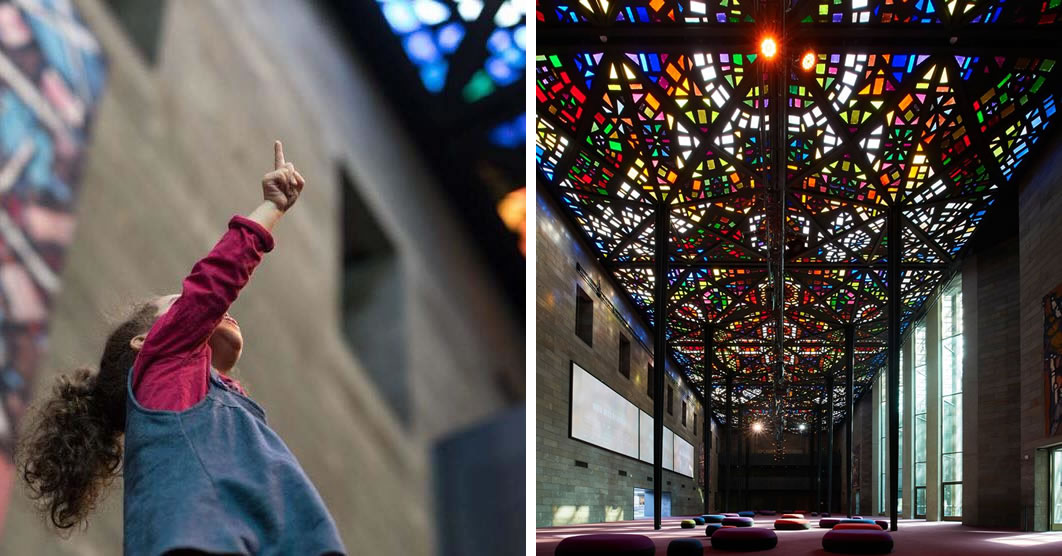NGV Great Hall & Waterwall |

Entry to NGV is free | Watching kids runs their fingers through the water or seeing the stain-glassed ceiling is a must to everyone.
NGV International is one of two Victorian public art galleries within one magnificent arts precinct on St Kilda Road.

Great Hall
The Grand Hall was opened on August 20, 1968.
Its magnificent ceiling is the world's largest stained-glass ceiling, designed by Australian artist Leonard French. The ceiling is high (13.72 metres), vast (60.9 x 15.24 metres) and so heavy with glass and steel that its downward projecting triangles need to be held up by a series of slim steel columns.
Each of the main intersecting triangles has been turned into thousands of geometric pieces of coloured and clear glass that have been cut so their facets bounce and refract coloured light.
The 224 triangles of diamond-cut primary colours weigh 300 kilograms each.
Many call it a Persian carpet of light!
The Great Hall is a large capacity function area, perfect for a memorable gala dinner, grand wedding receptions or large scale cocktail events, The Great Hall has an area of 775 square metres, with a capacity of 600 (theatre), 750 (banquet), 680 (banquet with dance floor), 1400 (cocktail).

Waterwall
Is there a child in any of us that does not remember running our fingers through the streaming water flowing down the water wall?
The Waterwall is located at the entrance to NGV International at St Kilda Road, Melbourne.
I was there
Great Hall Grand Opening
It was the gala of the decade. On August 20, 1968, on a cold night, Melbourne's elite turned up to see the National Gallery of Victoria's new St Kilda Road building. Famed architect Sir Roy Grounds' daring modern design wowed, but when the doors opened to the Great Hall - the sound of trumpets bursting through - it was Leonard French's huge stained-glass ceiling that had people in awe.
'It was pretty terrific,' recalls French of the evening. He felt like a superstar in front of the thousand-plus crowd. Fashion enthusiast Lady Grounds (who French remembers fancying) wore a mini skirt while men were encouraged to wear their military decorations. Sir Henry Bolte, then premier, did the opening honours.
French's profile as a painter had been rising in the early '60s. 'Alan McCulloch, the art critic, had written that my work would look good in stained glass,' says the now 84-year-old , 'and Roy (Grounds) thought McCulloch had said I'd done stained glass. He said, 'Lenny, how would you like to make the biggest glass ceiling in the world?' You'd hardly say no to that.'
French had his work cut out for him - he had never worked with glass before. Yet the Brunswick artist (he still lives there with his wife, Elaine) says working with glass felt like a natural progression from his paintings, which were also concerned with shape and colour. At his studio, an old flourmill in Heathcote, French drew life-sized sketches of the 224 triangle sections that make up the ceiling, which took five years to complete. 'I used to do the drawings on the ground floor,' he says, 'and I would go upstairs and look down on it. I'd have a long stick which I used to make marks.'
French, who left school at 14 to become an apprentice signwriter for A.C. Mence, enjoyed his large budget, importing slabs of fine glass from France and Belgium. His assistant, Les Hawkins, suggested they use a grinding machine to cut through it. When Hawkins said it would take about four hours to cut each piece, French simply ran a glass cutter along the surface and then cracked the glass with a hammer. 'It cut perfectly,' he says. 'We'd still be there if he'd had it his way.'
French enjoyed working at night. He would place the glass on a light bench so the colours shone brightly. 'I used to smoke cigars called Old Port, which were tipped at the end with port,' he says. 'When I would get cutting the glass at night, I'd suddenly look down at the floor and I'd smoked the whole bloody pack.' He always called it a night when the radio announced midnight.
French likes seeing people lying on the ground below the ceiling (affectionately known as the Persian Rug of Light), taking in the mosaic of glass as colours dance on the floor around them. 'One of the attendants used to get very cross,' he says, 'he used to go around telling everyone to get up and they refused. I remember saying to him, 'It doesn't matter how people enjoy it.''
❊ Venue | Location ❊
National Gallery of Victoria | NGV International [ view ]180 St Kilda Road, Southbank Victoria 3000 View Map
Telephone: +61 3 8620 2222
❊ Web Links ❊
➼ NGV Great Hall & Waterwall
Disclaimer: Check with the venue (web links) before making plans, travelling or buying tickets.
Accessibility: Contact the venue for accessibility information.
Update Page







